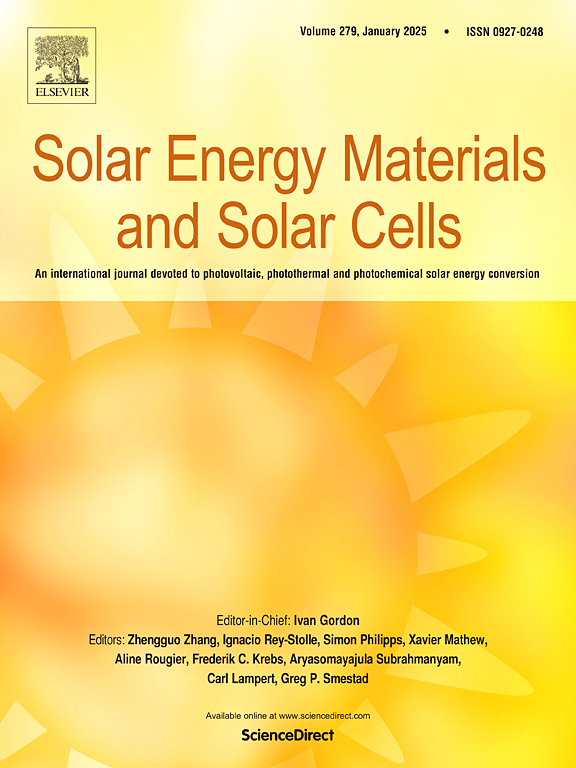Enhancement of thermal performance in parabolic trough solar Collectors: Investigation of three novel receiver configurations using advanced heat transfer fluids
IF 6.3
2区 材料科学
Q2 ENERGY & FUELS
引用次数: 0
Abstract
This study investigates the impact of novel receiver configurations and advanced heat transfer fluids on the thermal performance of parabolic trough solar collector receivers, utilising ANSYS Fluent 2021. Three novel configurations (Configs 2, 3, and 4) are compared to a conventional receiver (Config 1) using three different heat transfer fluids: Syltherm800 (reference), MWCTN-TiO2/Syltherm800, and liquid sodium. Key parameters analyzed include thermal efficiency, Nusselt number, friction factor, and circumferential temperature difference. The model is validated against experimental results and theoretical correlations. Results indicate that novel configurations outperform the conventional receiver, with Config 3 achieving the highest thermal performance. Among the fluids, liquid sodium exhibits the best thermal performance, followed by MWCTN-TiO2/Syltherm800. Using Syltherm800, thermal efficiency increases by 4%, the Nusselt number by 92.6%, and the friction factor by 167.38%, while the circumferential temperature difference decreases by 56.69%. Compared to Syltherm800, liquid sodium improves thermal efficiency by 3.4 % and the Nusselt number by 45.6%, while MWCTN-TiO2/Syltherm800 increases them by 2.97% and 32.8%, respectively. Liquid sodium also reduces the circumferential temperature difference by 80.4%, unlike 36.34% for MWCTN-TiO2/Syltherm800. Additionally, MWCTN-TiO2/Syltherm800 increases the friction factor by 34%, whereas liquid sodium reduces it by 38.3%. These findings highlight the effectiveness of turbulators in enhancing parabolic trough solar collector performance and demonstrate the advantage of newly developed heat transfer fluids in minimizing the circumferential temperature difference, thereby reducing receiver thermal stresses.
抛物面槽太阳能集热器热性能的增强:采用先进传热流体的三种新型集热器结构的研究
本研究利用ANSYS Fluent 2021研究了新型接收器配置和先进的传热流体对抛物面槽太阳能集热器接收器热性能的影响。使用三种不同的传热流体:Syltherm800(参考)、MWCTN-TiO2/Syltherm800和液态钠,将三种新型配置(配置2、3和4)与传统接收器(配置1)进行比较。分析的关键参数包括热效率、努塞尔数、摩擦系数和周向温差。根据实验结果和理论相关性对模型进行了验证。结果表明,新型结构优于传统的接收器,配置3达到了最高的热性能。其中,液态钠的热性能最好,其次是MWCTN-TiO2/Syltherm800。采用Syltherm800后,热效率提高4%,努塞尔数提高92.6%,摩擦系数提高167.38%,而周向温差降低56.69%。与Syltherm800相比,液态钠提高了3.4%的热效率,Nusselt数提高了45.6%,而MWCTN-TiO2/Syltherm800分别提高了2.97%和32.8%。液态钠还能将周向温差降低80.4%,而MWCTN-TiO2/Syltherm800的周向温差为36.34%。此外,MWCTN-TiO2/Syltherm800使摩擦系数提高了34%,而液态钠使摩擦系数降低了38.3%。这些发现突出了紊流器在提高抛物面槽太阳能集热器性能方面的有效性,并展示了新开发的传热流体在最小化周向温差从而减少接收器热应力方面的优势。
本文章由计算机程序翻译,如有差异,请以英文原文为准。
求助全文
约1分钟内获得全文
求助全文
来源期刊

Solar Energy Materials and Solar Cells
工程技术-材料科学:综合
CiteScore
12.60
自引率
11.60%
发文量
513
审稿时长
47 days
期刊介绍:
Solar Energy Materials & Solar Cells is intended as a vehicle for the dissemination of research results on materials science and technology related to photovoltaic, photothermal and photoelectrochemical solar energy conversion. Materials science is taken in the broadest possible sense and encompasses physics, chemistry, optics, materials fabrication and analysis for all types of materials.
 求助内容:
求助内容: 应助结果提醒方式:
应助结果提醒方式:


